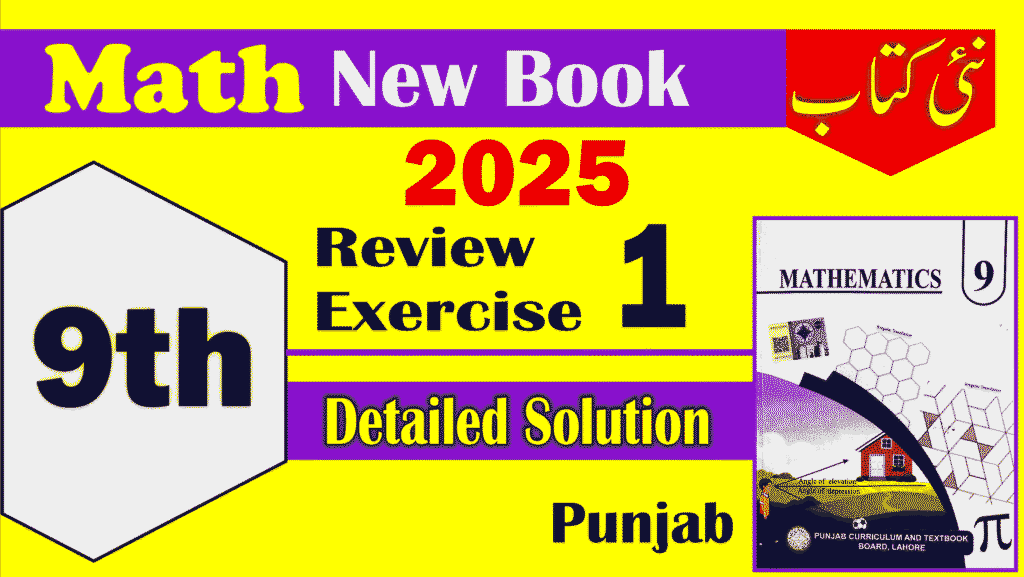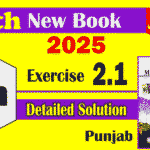9th Math Review Exercise1
9th Math Review Exercise1 2025 is an important exercise. In this exercise, we will review chapter 1 real numbers of math class 9. 1st question of the exercise is MCQs type and we will also solve the remaining short and long questions as well.
Q1 Four options are given against each statement. Encircle the correct option.
(i) $$\sqrt7\;is$$
(a) integer (b) rational number (c) irrational number (d) natural number
$$\sqrt7\;is\;an\;irrational\;number$$
option c is correct.
(ii) $$\mathrm\pi\;\mathrm{and}\;\mathrm e\;\mathrm{are}$$
(a) natural numbers (b) integers (c) rational numbers (d) irrational numbers
$$\mathrm\pi\;\mathrm{and}\;\mathrm e\;\mathrm{are}\;\mathrm{irrational}\;\mathrm{numbers}$$
option d is correct.
(iii) $$If\;n\;is\;not\;a\;perfct\;square,\;then\;\sqrt n\;is$$
(a) rational number (b) natural number (c) integer (d) irrational number
$$\sqrt n\;is\;irrational\;number\;if\;n\;is\;not\;perfect\;square$$
option d is correct.
(iv) $$\sqrt3+\sqrt5\;is$$
(a) whole number (b) integer (c) rational number (d) irrational number
$$\sqrt3+\sqrt5\;is\;an\;irrational\;number$$
option d is correct
(v) $$For\;all\;x\in\mathbb{R},\;x=x\;is\;called$$
(a) reflexive property (b) transitive number (c) symmetric property (d) trichotomy property
$$For\;all\;x\in\mathbb{R},\;x=x\;is\;called\;Reflexive\;property$$
option c is correct
(vi) $$Let\;a,b,c\;\in\mathbb{R},\;then\;a>b\;and\;b>c$$
$$\Rightarrow\;a>c\;is\;called$$
(a) trichotomy property (b) transitive property (c) additive property (d) multiplicative property
$$a>b\;and\;b>c\;\Rightarrow\;a>c\;is\;called\;transitive\;property$$
option b is correct
(vii) $$2^x\;\times\;8^x\;=\;64\;then\;x=$$
(a) 3/2 (b) 3/4 (c) 5/6 (d) 2/3
$$\;x=\frac32$$
option a is correct
(viii) $$Let\;a,b\;\in\mathbb{R},\;then\;a=b\;and\;b=a\;is\;called$$
(a) reflexive property (b) symmetric property (c) transitive property (d) additive property
$$a=b\;and\;b=a\;is\;called\;symmetric\;property$$
option b is correct
(ix) $$\sqrt{75}\;+\;\sqrt{27}\;=$$
$$(a)\;\sqrt{102}\;\;\;(b)\;\;9\sqrt3\;\;\;(c)\;\;5\sqrt3\;\;\;(d)\;\;8\sqrt3$$
$$\sqrt{75}\;+\;\sqrt{27}\;=\;5\sqrt3\;+\;3\sqrt3\;=\;8\sqrt3$$
option d is correct
(x) $$The\;product\;of\;\;(\;3+\sqrt5\;)\;(\;\;3-\sqrt5\;)\;is$$
(a) prime number (b) odd number (c) irrational number (d) rational number
$$(\;3+\sqrt5\;)\;(\;\;3-\sqrt5\;)\;is\;a\;rational\;number\\$$
option d is correct
————————————————————————-
Q2 If a=3/2 , b=5/3 and c=7/5, then verify that
(i) a ( b + c ) = a b + a c
$$L.H.S\;=\;a\;(\;b\;+\;c\;)\\=\;\frac32\;(\;\frac53\;+\;\frac75\;)\\=\;\frac32\;(\;\frac{5\times5\;+\;7\times3}{15})\\=\;\frac32\;(\;\frac{25\;+\;21}{15})\\=\;\frac32\;(\frac{46}{15})\\=\frac{138}{30}\;=\;\frac{23}5$$
$$R.H.S\;=\;ab\;+\;ac\\=\;\frac32\times\frac53\;+\;\frac32\times\frac75\\=\;\frac52\;+\;\frac{21}{10}\\=\;\frac{5\times5\;+\;21\times1}{10}\\=\frac{25+21}{10}\\=\frac{46}{10}\;=\;\frac{23}5$$
L.H.S = R.H.S = 23/5
(ii) ( a + b ) c = a c + b c
$$L.H.S\;=\;(\;a\;+\;b\;)\;c\\=\;(\;\frac32\;+\;\frac53\;)\;\frac75\\=\;(\;\frac{3\times3\;+\;2\times5}6\;)\;\frac75\\=(\;\frac{9\;+10}6)\frac75\\=(\frac{19}6)\;\frac75\\=\;\frac{133}{30}$$
$$R.H.S\;=\;\;a\;c\;+\;b\;c\\=\;\frac32\times\frac75\;+\;\frac53\times\frac75\\=\;\frac{21}{10}\;+\;\frac73\\=\;\frac{3\times21\;+\;10\times7}{30}\\=\frac{63\;+\;70}{30}\\=\frac{133}{30}$$
L.H.S = R.H.S = 133/30
————————————————————————-
Q3 If a=4/3, b=5/2, c=7/4, then verify the associate property of real numbers w.r.t addition and multiplication.
Associate property of real numbers w.r.t addition is
a + ( b + c ) = ( a + b ) + c
$$L.H.S\;=\;a\;+\;(\;b\;+\;c\;)\\=\frac43\;+\;(\;\frac52\;+\;\frac74\;)\\=\;\frac43\;+\;(\;\frac{2\times5\;+\;1\times7}4)\\=\frac43+\;(\;\frac{10\;+\;7}4\;)\\=\frac43\;+\;\frac{17}4\\=\;\frac{4\times4\;+\;3\times17}{12}\\=\;\frac{16\;+\;51}{12}\\=\;\frac{67}{12}$$
$$R.H.S\;=(\;a\;+\;\;b\;)\;+\;c\;\\=(\;\frac43\;+\;\frac52\;)+\;\frac74\\=\;(\;\frac{2\times4\;+\;3\times5}6)\;+\;\frac74\\=\;(\frac{8+15}6)\;+\;\frac74\\=\;\frac{23}6+\frac74\\=\;\frac{2\times23\;+\;3\times7}{12}\\=\;\frac{46\;+\;21}{12}\\=\;\frac{67}{12}$$
L.H.S = R.H.S = 67/12
Associate property of real numbers w.r.t multiplication is
a ( b c ) = ( a b ) c
$$L.H.S\;=\;a\;(\;b\;c\;)\\=\;\frac43\;(\;\frac52\;\times\;\frac74\;)\\=\;\frac43\;(\;\frac{35}8\;)\\=\;\frac{35}6$$
$$R.H.S\;=\;(\;a\;b\;)\;c\\=(\;\frac43\;\times\;\frac52\;)\;\;\frac74\\=(\;\frac{10}3\;)\;\frac74\\=\;\frac{35}6$$
L.H.S = R.H.S = 35/6
————————————————————————-
Q4 Is 0 a rational number ? Explain.
Yes 0 is a rational number because 0 = 0.000………
Zero is non-terminating and non-recurring decimal number.
0 divided by any integer, other than 0,will give us 0. Hence, according to the definition of rational number, 0 is rational.
————————————————————————-
Q5 State trichotomy property of real numbers.
Trichotomy property:-
For all real numbers a and b
either a=b or a>b or a<b
————————————————————————-
Q6 Find two rational numbers between 4 and 5.
$$Average\;of\;4\;and\;5\;=\frac{4+5}2=\frac92\\Average\;of\;\frac92\;and\;5\;=\;\frac{{\displaystyle\frac92}+5}2\\=\frac{\displaystyle\frac{9+10}2}2=\frac{\displaystyle\frac{19}2}2=\frac{19}4$$
Hence required rational numbers are 9/2 and 19/4
————————————————————————-
Q7 Simplify the following:
(i) $$\sqrt[5]{\frac{x^{15}\;y^{35}}{z^{20}}}$$
$$=\;\sqrt[5]{\frac{\;{(x^3)}^5\;\;{(x^7)}^5}{\;{(z^4)}^5}}\\\\\\=\sqrt[5]{{\;(\frac{x^3\;x^7}{z^4})}^5}\\\\=\frac{x^3\;x^7}{z^4}$$
(ii) $$\sqrt[3]{{(27)}^{2x}}$$
$$=\;\sqrt[3]{{(3^3)}^{2x}}\\\\={\;(3^{6x})}^\frac13\\\\={(3)}^{6x\times\frac13}\\\\=3^{2x}$$
(iii) $$\frac{6\;{(3)}^{n+2}}{3^{n+1}\;-\;3^n}$$
$$=\;\frac{6\;{(3)}^n\;{(3)}^2}{3^n\;{(3)}^1\;-\;3^n}\\\\=\frac{6\;{(3)}^n\;9}{3^n\;{(\;(3)}^1\;-\;1\;)}\\\\=\frac{6\times9}{3-1}\\\\=\frac{54}2\\\\=27$$
————————————————————————-
Q8 The sum of three consecutive odd integers is 51. Find the three integers.
Let the three consecutive odd integers are 2x+1 , 2x+3 and 2x+5
According to the given condition.
2x+1 + 2x+3 + 2x+5 = 51
6x + 9 = 51 or 6x = 51-9 or 6x = 42
Dividing both the sides by 6
x = 42/6 = 7
Integers are
2x+1 = 2(7) +1 = 15
2x+3 = 2(7) + 3 = 17
2x+5 = 2(7) + 5 = 19
————————————————————————-
Q9 Abdullah picked up 96 balls and placed them into two buckets. One bucket has twenty-eight more balls than the other bucket. How many balls were in each bucket ?
Let the balls in 1st bucket = x
Let the balls in 2nd bucket = x+28
x+x+28 = 96
2x = 96-28
2x = 68
x = 34
Balls in 1st bucket = 34
balls in 2nd bucket = 34 + 28 = 62
————————————————————————-
Q 10$$Salma\;invested\;Rs\;3,50,000\\in\;a\;bank,\;which\;paid\\simple\;profit\;at\;the\;rate\;of\\7\frac14\;\%\;annum.\;After\;2\;years,\\the\;rate\;was\;increased\;to\\8\;\%\;per\;annum.\;Find\\the\;amount\;she\;had\;at\\the\;end\;of\;7\;years.\;$$
$$Total\;investment\;=\;3,50,000\\For\;1st\;year=3,50,000\times7\frac14\%\\=3,50,000\;\times\frac{29}4\;\%\\=3,50,000\;\times7.25\;\%\\=\;3,50,000\;\times\frac{725}{100}\;\%\\=3500\;\times725\%\\=3500\;\times\frac{725}{100}\\=\;35\;\times725\;=\;25375\;Rs\;$$
$$Investment\;for\;2nd\;year\\=\;25375\;\times2\;=\;50750\;Rs\\$$
$$Investment\;for\;3rd\;year\\=\;3,50,000\;\times\;8\;\%\\=\;3,50,000\;\times\frac8{100}\\=\;3500\;\times\;8\;=\;28000\\$$
$$Investment\;for\;last\;5\;years\\=\;28000\;\times\;5\\=\;140000\\$$
Total interest = 50750 + 140000 = 190750
Total amount = 350000 + 190750 = 540750
————————————————————————-
Check! some important link




